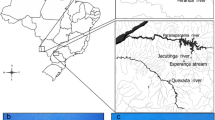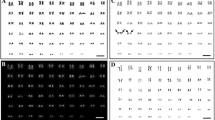Abstract
The karyotypes of five Brazilian species of Echinodorus; E. bolivianus, E. grandiflorus, E. longipetalus, E. macrophyllus and E. tenellus (Alismataceae); were studied using C-banding, CMA3/DAPI banding and fluorescence in situ hybridization with a 45S rDNA probe. There were few differences in the G-C rich regions of the five species, but marked differences were seen in the number and position of C-bands, A-T rich regions and 45S rDNA sites. Overall, these characteristics were species-specific, with the exception of E. bolivianus and E. tenellus, which were highly similar in all of the karyotypic characteristics studied.
Similar content being viewed by others
References
J. Y. Costa E. R. Forni-Martins (2003) ArticleTitleKaryology of some Brazilian species of Alismataceae Bot. J. Linn. Soc 143 159–164 Occurrence Handle10.1046/j.1095-8339.2003.00193.x
J. Y. Costa E. R. Forni-Martins (2004) ArticleTitleA triploid cytotype of Echinodorus tenellus Aquat. Bot 79 325–332 Occurrence Handle10.1016/j.aquabot.2004.05.004 Occurrence Handle1:CAS:528:DC%2BD2cXlvVWms74%3D
A. Cronquist (1988) The evolution and classification of flowering plants The New York Botanical Garden New York
R. Dahlgren V. Clifford (1981) The Monocotyledons: a comparative study Academic Press New York
E. R. Forni-Martins K. P. Calligaris (2002) ArticleTitleChromosomal studies on Neotropical Limnocharitaceae (Alismatales) Aquat. Bot 74 33–41 Occurrence Handle10.1016/S0304-3770(02)00038-4 Occurrence Handle1:CAS:528:DC%2BD38XlsVKnu74%3D
E. R. Forni-Martins M. Guerra (1999) ArticleTitleLongitudinal differentiation in chromosomes of some Sesbania Scop. species (Fabaceae) Caryologia 52 97–103
J. N. Fregonezi J. M. D. Torezan A. L. L. Vanzela (2004) ArticleTitleA karyotypic study of three southern Brazilian Asteraceae species using fluorescence in situ hybridization with a 45S rDNA probe and C-CMA3 banding Braz. J. Genet 27 223–227 Occurrence Handle1:CAS:528:DC%2BD2cXnslOnsbk%3D
W. L. Gerlach J. R. Bedbrook (1979) ArticleTitleCloning and characterization of ribosomal RNA genes from wheat and barley Nucleic Acids Res 7 1869–1885 Occurrence Handle1:CAS:528:DyaL3cXlsFamsQ%3D%3D Occurrence Handle537913
J. Greilhuber B. Deumling F. Speta (1981) ArticleTitleEvolutionary aspects of chromosome banding, heterochromatin, satellite DNA, and genome size in Scilla (Liliaceae) Ber. Deutsch. Bot. Ges 94 249–266 Occurrence Handle1:CAS:528:DyaL3MXmtVSksr8%3D
M. Guerra (2000) ArticleTitlePatterns of heterochromatin distribution in plant chromosomes Braz. J. Genet 23 1029–1041
R. R. Haynes L. B. Holm-Nielsen (1994) The Alismataceae. Flora Neotropica. Monograph 64 The New York Botanical Garden New York
M. D. Jacobs R. C. Gardner B. G. Murray (2000) ArticleTitleCytological characterization of heterochromatin and rDNA in Pinus radiata and P. taeda Pl. Syst. Evol 223 71–79 Occurrence Handle10.1007/BF00985327 Occurrence Handle1:CAS:528:DC%2BD3cXlvFWgt7s%3D
J. Jérémie D. Lobreau-Callen H. Couderc A. Jossang (2001) ArticleTitleUne nouvelle espece d´Echinodorus (Alismataceae) de Guadeloupe (Petites Antilles). Observations palynologiques, cytogénétiques et chimiques Adansonia 23 191–203
W. S. Judd C. S. Campbell E. A. Kellogg P. F. Stevens (1999) Plant systematics: a phylogenetic approach Sinauer Associates Inc Sunderland
A. Kenton (1981) ArticleTitleA Robertsonian relationship in the chromosomes of two species of Hydrocleys Kew Bull 36 487–492
A. R. Leitch T. Schwarzacher D. Jackson I. J. Leitch (1994) In situ hybridization BIOS Scientific Publishers Ltd Oxford
D. H. Les R. R. Haynes (1995) Systematic of subclass Alismatidae: a synthesis of approaches P. J. Rudall P. J. Cribb D. F. Cutler C. J. Humphries (Eds) Monocotyledons: systematics and evolution Royal Botanic Gardens Kew 353–377
D. H. Les C. T. Philbrick (1993) ArticleTitleStudies of hybridization and chromosome number variation in aquatic angiosperms: evolutionary implications Aquat. Bot 44 181–228 Occurrence Handle10.1016/0304-3770(93)90071-4
E. A. Moscone M. Lambrou F. Ehrendorfer (1996) ArticleTitleFluorescent chromosome banding in the cultivated species of Capsicum (Solanaceae) Pl. Syst. Evol 202 37–63 Occurrence Handle10.1007/BF00985817
Y. Ran B. G. Murray K. R. W. Hammett (1999) ArticleTitleKaryotype analysis of the genus Clivia by Giemsa and fluorochrome banding and in situ hybridization Euphytica 106 139–147 Occurrence Handle10.1023/A:1003572705445
T. Schwarzacher P. Ambros D. Schweizer (1980) ArticleTitleApplication of Giemsa banding to orchid karyotype analysis Pl. Syst. Evol 134 239–297 Occurrence Handle10.1007/BF00986805
D. Schweizer (1976) ArticleTitleReverse fluorescent chromosome banding with Chromomycin and DAPI Chromosoma 58 307–324 Occurrence Handle10.1007/BF00292840 Occurrence Handle1:STN:280:CSiD28fhtFM%3D Occurrence Handle137107
N. Tagashira K. Kondo (2001) ArticleTitleChromosome phylogeny of Zamia and Ceratozamia by means of Robertsonian changes detected by fluorescence in situ hybridization (FISH) technique of rDNA Pl. Syst. Evol 227 145–155 Occurrence Handle10.1007/s006060170045 Occurrence Handle1:CAS:528:DC%2BD3MXms1ehs78%3D
A. L. L. Vanzela C. F. Ruas M. F. Oliveira P. M. Ruas (2002) ArticleTitleCharacterization of diploid, tetraploid and hexaploid Helianthus species by chromosome banding and FISH with rDNA probe Genetica 114 105–111 Occurrence Handle10.1023/A:1015171625890 Occurrence Handle1:CAS:528:DC%2BD38XksFSktLw%3D Occurrence Handle12041823
J. W. Wooten (1986) ArticleTitleVariations in leaf characteristics of six species of Sagittaria (Alismataceae) caused by various water levels Aquat. Bot 23 321–327 Occurrence Handle10.1016/0304-3770(86)90080-X
Author information
Authors and Affiliations
Corresponding author
Rights and permissions
About this article
Cite this article
Costa, J.Y., Forni-Martins, E.R. & Vanzela, A.L.L. Karyotype characterization of five Brazilian species of Echinodorus (Alismataceae) with chromosomal banding and 45S rDNA FISH. Plant Syst. Evol. 257, 119–127 (2006). https://doi.org/10.1007/s00606-005-0375-8
Received:
Accepted:
Published:
Issue Date:
DOI: https://doi.org/10.1007/s00606-005-0375-8




